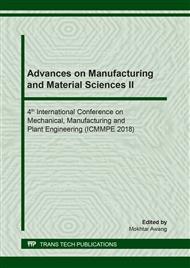[1]
A. G. Evans, M. D. Drory, M. S. Hu, The cracking a decohesion of thin films, J. Mater. Res. 3 (1988) 1043–1049.
DOI: 10.1557/jmr.1988.1043
Google Scholar
[2]
C. W. Kang, H. Huang, Deformation, failure and removal mechanisms of thin film structures in abrasive machining, Adv. Manuf. 5 (2017) 1–19.
DOI: 10.1007/s40436-016-0165-2
Google Scholar
[3]
X. Geng, Z. Zhang, E. Barthel, D. Dalmas, Mechanical stability under sliding contact of thin silver film embedded in brittle multilayer, Wear. 276–277 (2012) 111–120.
DOI: 10.1016/j.wear.2011.12.016
Google Scholar
[4]
D. Cong et al., Wear behavior of corroded Al-Al2O3 composite coatings prepared by cold spray, Surf. Coatings Technol. (2017) 326 247–254.
DOI: 10.1016/j.surfcoat.2017.07.063
Google Scholar
[5]
C. H. Chang, M. C. Jeng, C. Y. Su, C. L. Chang, An investigation of thermal sprayed aluminum/hard anodic composite coating on wear and corrosion resistant performance, Thin Solid Films. 517 (2009) 5265–5269.
DOI: 10.1016/j.tsf.2009.03.153
Google Scholar
[6]
O. P. Oladijo, N. Sacks, L. A. Cornish, A. M. Venter, Effect of substrate on the 3 body abrasion wear of HVOF WC-17 wt.% Co coatings, Int. J. Refract. Met. Hard Mater. 35 (2012) 288–294.
DOI: 10.1016/j.ijrmhm.2012.06.011
Google Scholar
[7]
F. Changjie, C. En, Effects of Substrate Temperature on Microstructure and Tribological Properties of Ti-Al-Si-Cu-N Films Deposited by Magnetron Sputtering, Rare Met. Mater. Eng. 46 (2017) 1497–1502.
DOI: 10.1016/s1875-5372(17)30153-4
Google Scholar
[8]
M. Anand, G. Burmistroviene, I. Tudela, R. Verbickas, G. Lowman, Y. Zhang, Tribological evaluation of soft metallic multilayer coatings for wear applications based on a multiple pass scratch test method, Wear. 388–389 (2017) 39–46.
DOI: 10.1016/j.wear.2017.01.119
Google Scholar
[9]
F. M. Mwema, O. P. Oladijo, T. S. Sathiaraj, E. T. Akinlabi, Atomic force microscopy analysis of surface topography of pure thin aluminium films, Mater. Res. Express. 5 (2018) 1–15.
DOI: 10.1088/2053-1591/aabe1b
Google Scholar
[10]
F. M. Mwema, O. P. Oladijo, E. T. Akinlabi, Effect of substrate temperature on Aluminium thin films prepared by RF-magnetron sputtering, Materials Today: Proceedings. 5 (2018) 20464-20473.
DOI: 10.1016/j.matpr.2018.06.423
Google Scholar


